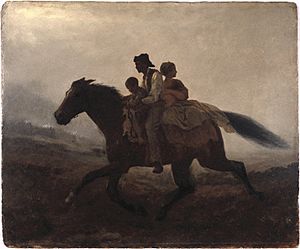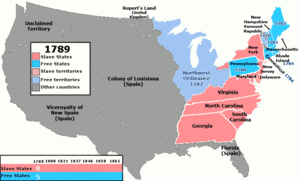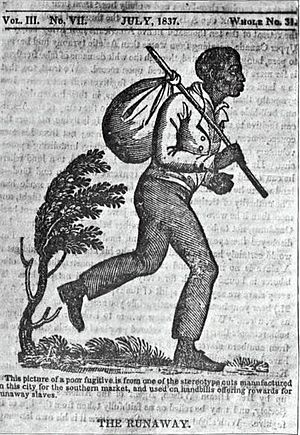Fugitive slaves in the United States facts for kids

In the United States, fugitive slaves or runaway slaves were terms used in the 18th and 19th century to describe people who fled slavery. The term also refers to the federal Fugitive Slave Acts of 1793 and 1850. Such people are also called freedom seekers to avoid implying that the slave had committed a crime and that the slaveholder was the injured party.
Generally, they tried to reach states or territories where slavery was banned, including Canada, or, until 1821, Spanish Florida. Most slave law tried to control slave travel by requiring them to carry official passes if traveling without a master.
Passage of the Fugitive Slave Act of 1850 increased penalties against runaway slaves and those who aided them. Because of this, some freedom seekers left the United States altogether, traveling to Canada or Mexico. Approximately 100,000 American slaves escaped to freedom.
Contents
Laws
Beginning in 1643, the slave laws were enacted in Colonial America, initially among the New England Confederation and then by several of the original Thirteen Colonies. In 1705, the Province of New York passed a measure to keep bondspeople from escaping north into Canada.

Over time, the states began to divide into free and slave states. Maryland and Virginia passed laws to offer rewards to people who captured and returned escaped slaves to their owners. Slavery was abolished in five states by the time of the Constitutional Convention in 1787. At that time, New Hampshire, Vermont, Massachusetts, Connecticut and Rhode Island had become free states.
Constitution
Legislators from the Southern United States were concerned that free states would offer protection for people who fled slavery. The United States Constitution, ratified in 1788, never uses the words "slave" or "slavery", but recognized its existence in the so-called fugitive slave clause (Article IV, Section 2, Clause 3), the three-fifths clause, and the prohibition on prohibiting importation of "such Persons as any of the States now existing shall think proper to admit" (Article I, Section 9).
Fugitive Slave Act of 1793
The Fugitive Slave Act of 1793 is the first of two federal laws that allowed for runaway slaves to be captured and returned to their slave holders. It was enacted in 1793 by the Congress to allow agents for the slaveholders and local governments, including free states, in tracking and capturing bondspeople. They were also able to penalize individuals with a $500 (Error when using : |start_year=1793 (parameter 3) is lower than the earliest available year (1800) in index "US".) fine if they assisted African Americans in their escape. The slave hunters were required to get a court-approved affidavit to capture the slave. Northerners thought that this meant that it was like legalized kidnapping and deplored the idea of slave hunters stalking through their state. It resulted in the creation of a network of safe houses, called the Underground Railroad.
Fugitive Slave Act of 1850
The Fugitive Slave Act of 1850, part of the Compromise of 1850, was a law enacted by the Congress that declared that all fugitive slaves should be returned to their masters. Because the South agreed to have California enter as a free state, the North allowed the Fugitive Slave Act of 1850 to be created. The act was passed on September 18, 1850, and it was repealed on June 28, 1864. The act strengthened the authority of the federal government in the capturing of fugitive slaves. The act authorized federal marshals to require Northern citizen bystanders to aid in the capturing of runaways. Many Northerners perceived the legislation as a way in which the federal government overstepped its authority, due to the fact that the legislation could be used to force Northerners to act against their abolitionist beliefs. Many Northern states eventually passed "personal liberty laws", which prevented the kidnapping of alleged runaway slaves; however, in the court case known as Prigg v. Pennsylvania, the personal liberty laws were ruled unconstitutional on the grounds that the capturing of fugitive slaves was a federal matter in which states did not have the power to interfere.
Many Northern citizens were outraged at the criminalization of actions by Underground Railroad operators and abolitionists who helped people escape slavery. It is considered one of the causes of the American Civil War (1861–1865). The Fugitive Acts of 1793 and 1850 were repealed on June 28, 1864, by an act of Congress.
State laws
Many states tried to nullify the new slave act or prevent capture of escaped slaves by setting up new laws to protect their rights. The most notable is the Massachusetts Liberty Act. This Act was passed in order to keep escaped slaves from being returned to their masters through abduction by federal marshals or bounty hunters. Wisconsin and Vermont also enacted legislation to bypass the federal law. Abolitionists became more involved in Underground Railroad operations.
Pursuit
Advertisements and rewards
When the slaves were found missing, masters were outraged, many of them believing that slavery was good to the slave, and if they ran away it was the work of Northern abolitionists, with one arguing that "They are indeed happy, and if let alone would still remain so". (A new name was invented for the supposed mental illness of a slave that made him or her want to run away: drapetomania.) Flyers would be put up, advertisements placed in newspapers, rewards offered, and posses send out to find him or her. Under the new Fugitive Slave Act they could now send federal marshals into the North to extract them. This new law also brought bounty hunters into the business of returning slaves to their masters; a former slave could be brought back into the South to be sold back into slavery, if he/she was without freedom papers. In 1851, there was a case of a black coffeehouse waiter who was kidnapped by federal marshals on behalf of John Debree, who claimed to be the man's enslaver.
Capture
Escaped slaves often faced harsh punishments after being captured, such as amputation of limbs, whippings, branding, and hobbling.
Individuals who aided fugitive slaves were charged and punished under this law. In the case of Ableman v. Booth, the latter was charged with aiding Joshua Glover's escape in Wisconsin by preventing his capture by federal marshals. The Wisconsin Supreme Court ruled that the Fugitive Slave Act of 1850 was unconstitutional, as it required states to violate their own laws in protecting slavery. Ableman v. Booth was appealed by the federal government to the US Supreme Court, which upheld the constitutionality of the Act.
The Underground Railroad
The Underground Railroad was a network of black and white abolitionists between the late 18th century and the end of the Civil War who helped fugitive slaves escape to freedom. Members of the Religious Society of Friends (Quakers), African Methodist Episcopal Church, Baptists, Methodists and other religious sects helped in operating the Underground Railroad.
In 1786, George Washington complained that a Quaker tried to free one of his slaves. In the early 1800s, Isaac T. Hopper, a Quaker from Philadelphia, and a group of people from North Carolina established a network of stations in their local area. In 1831, when Tice David was captured going into Ohio from Kentucky, his owner blamed an "Underground Railroad" who helped in escape. Eight years later, while being tortured for his escape, a man named Jim said that he was going north along the "underground railroad to Boston."
Fellow slaves often helped those who had run away. They gave signals, such as the lighting of a particular number of lamps, or the singing of a particular song on Sunday, to let escaping people know if it was safe to be in the area of if there were slave hunters nearby. If the freedom seeker stayed in a slave cabin, they would likely get food and learn good hiding places in the woods as they made their way north.
Hiding places called "stations" were set up in private homes, churches, and schoolhouses in border states between slave and free states. John Brown had a secret room in his tannery to give escaped slaves places to stay on their way. People who maintained the stations provided food, clothing, shelter, and instructions about reaching the next "station". Often, slaves had to make their way through southern slave states on their own to reach them.
The network extended throughout the United States—including Spanish Florida, Indian Territory, and Western United States—and into Canada and Mexico. The Underground Railroad was initially an escape route that would assist fugitive enslaved African Americans in arriving in the Northern states; however, with the passage of the Fugitive Slave Act of 1850, as well as other laws aiding the Southern states in the capture of runaway slaves, it became a mechanism to reach Canada. Canada was a safe haven for African-American slaves because it had already abolished slavery by 1783. Blacks in Canada were also provided equal protection under the law. The well-known Underground Railroad "conductor" Harriet Tubman is said to have led approximately 300 slaves to Canada. In some cases, freedom seekers immigrated to Europe and the Caribbean islands.
Harriet Tubman
One of the most notable runaway slaves of American history and conductors of the Underground Railroad is Harriet Tubman. Born into slavery in Dorchester County, Maryland, around 1822, Tubman as a young adult escaped from her master's plantation in 1849. Between 1850 and 1860, she returned to the South numerous times to lead parties of other slaves to freedom, guiding them through the lands she knew well. She aided hundreds of people, including her parents, in their escape from slavery. Tubman followed north–south flowing rivers and the north star to make her way north. She preferred to guide runaway slaves on Saturdays, because newspapers were not published on Sundays, which gave her a one-day head-start before runaway advertisements would be published. She preferred the winters, because the nights, when it was the safest to travel, were longer. Tubman wore disguises. She sang songs in different tempos, such as Go Down Moses and Bound For the Promised Land, to indicate whether it was safe for freedom seekers to come out of hiding. Many people called her the "Moses of her people." During the American Civil War, Tubman also worked as a spy, cook, and as a nurse.
Notable people
Notable people who gained or assisted others in gaining freedom via the Underground Railroad include:
- Henry "Box" Brown
- John Brown (abolitionist), who would later lead the 1859 raid on Harper's Ferry. He had a hidden room in his tannery building for fugitive slaves.
- Owen Brown, father of John Brown
- Elizabeth Margaret Chandler
- Levi Coffin
- Frederick Douglass
- Calvin Fairbank
- Thomas Garrett
- Shields Green
- Laura Smith Haviland
- Lewis Hayden
- Josiah Henson
- Isaac Hopper
- Roger Hooker Leavitt
- Samuel J. May
- Dangerfield Newby
- John Parker
- John Wesley Posey
- John Rankin
- Alexander Milton Ross
- David Ruggles
- Samuel Seawell
- James Lindsay Smith
- William Still
- Sojourner Truth
- Harriet Tubman
- Charles Augustus Wheaton
Communities
Colonial America
United States
Civil War
- Camp Greene (Washington, D.C.) - Civil war camp
- Theodore Roosevelt Island - Civil war camp
Canada
- Africville - Nova Scotia
- Birchtown - Nova Scotia
- Dawn settlement - Ontario
- Elgin settlement - Ontario
- Fort Malden - Ontario
- Queen's Bush - Ontario
See also
 In Spanish: Esclavos fugitivos en los Estados Unidos para niños
In Spanish: Esclavos fugitivos en los Estados Unidos para niños
- Abolitionism
- Maroon (people), African refugees who escaped slavery in the Americas and formed settlements
- Slave Trade Compromise and Fugitive Slave Clause


